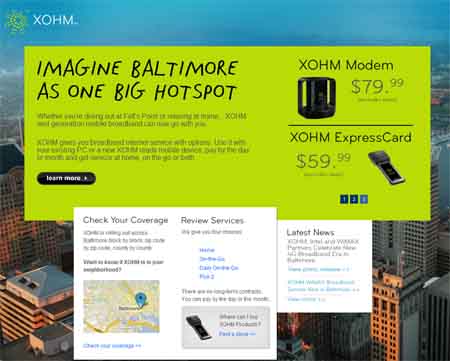Laptops with mobile WiMax now available

The first laptops with built-in mobile WiMax wireless broadband are now available in the U.S. Sprint, Intel and the computer companies announced the new WiMax configurations at an event in Baltimore just a few days after Sprint launched its Xohm service there.
All of these laptops use Intel's Echo Peak chipset, formally known as the WiMax/WiFi Link 5350, which is part of the Centrino 2 platform. The chipset supports mobile WiMax (or 802.16e) at speeds up to 10Mbps downstream and 4Mbps upstream. The WiMax chipset currently adds about $60 to the cost of a notebook--more than Xohm had initially targeted but less than competing 3G data modems. For example, a 3G adapter for AT&T or Verizon is a $120 option on the Lenovo ThinkPad X301 (not including special offers). The eight laptop models are:
- Acer Aspire 4930-6862
- Acer Aspire 6930-6771
- Asus M50Vm-A1WM
- Lenovo ThinkPad SL300
- Lenovo ThinkPad SL500
- Lenovo ThinkPad T400
- Lenovo ThinkPad X301
- Toshiba Satellite U405-ST550W
These WiMax configurations are sold direct, at a handful of online retailers (Amazon.com, Newegg.com and TigerDirect.com) and at Best Buy stores in the Baltimore area. At the even Xohm CEO Barry West said there would be a dozen laptops with WiMax available by December. Lenovo said it would also add WiMax options to the ThinkPad SL400, ThinkPad W500, ThinkPad X200, ThinkPadW700 and IdeaPad Y530. Other devices include a home modem, ExpressCard and USB adapters and the Nokia 810 Internet Tablet, which is essentially a Mobile Internet Device (MID), though it uses a Texas Instruments OMAP processor rather than Intel's Atom chip.
Many blogs and industry publications have poked fun at the initial coverage area--admittedly it does seem a bit strange to be rolling out Intel chipsets, laptops and other devices for a service that only works in a city with a little more than 600,000 people--but you've got to start somewhere. If the Xohm/Clearwire merger goes smoothly, and Xohm continues to receive support from big names such as Google, Intel, Comcast and Time-Warner--the build-out could happen quickly. Next up are Boston, Dallas, Fort Worth, Philadelphia and Providence. We could also see multi-mode devices that work on both WiMax and Sprint's EV-DO network with some combination pricing plans.
There are plenty of other open questions. Even if Xohm can quickly expand its network, it isn't clear whether the company has the backhaul network to support a speedy, nationwide broadband network. Lately I've heard lots of rumblings that the battery life of WiMax devices--while improved--is not going to rival 3G smartphones. Since WiMax gadgets won't replace cell phones anytime soon, the pricing plans need to be simple and compelling enough to convince consumers to sign-on to another monthly mobile data plan--albeit one that doesn't require a contract. The "Pick 2" plan that lets you put a home modem and a laptop on the same bill for $50 a month "for life" is a great start, but it's tough to market a mobile service that can also replace home broadband and it will be competing with aggressively-priced "triple-play" packages. If Xohm can navigate these issues, it could gain a nice headstart on 3G and LTE data services.
